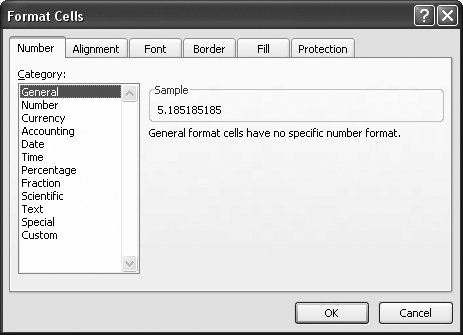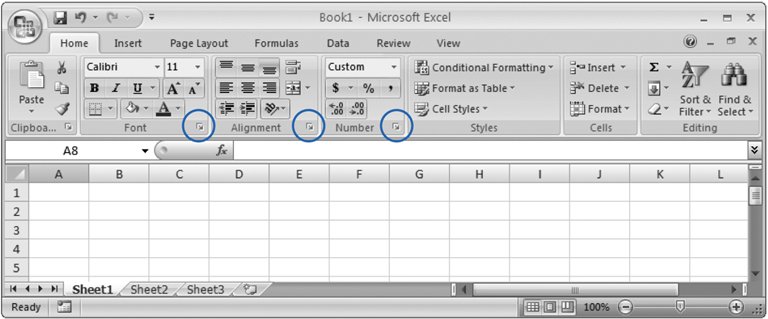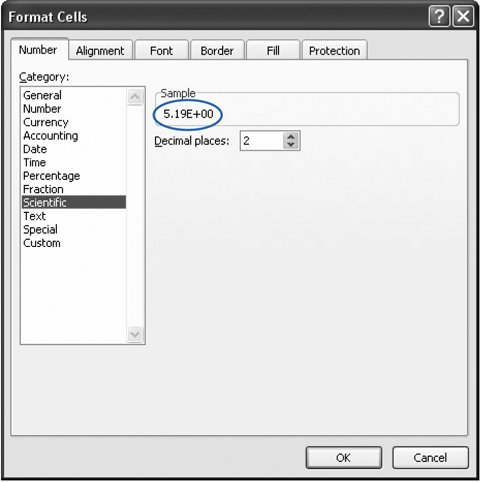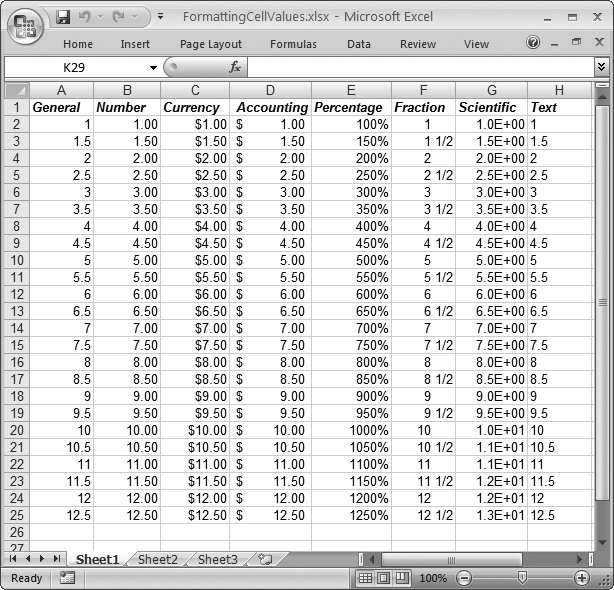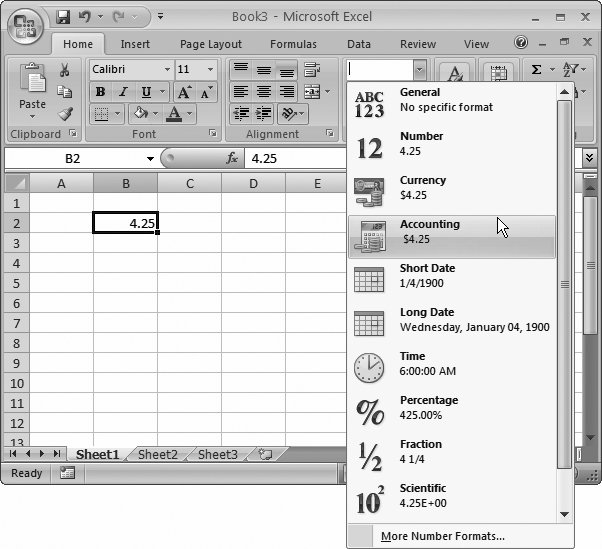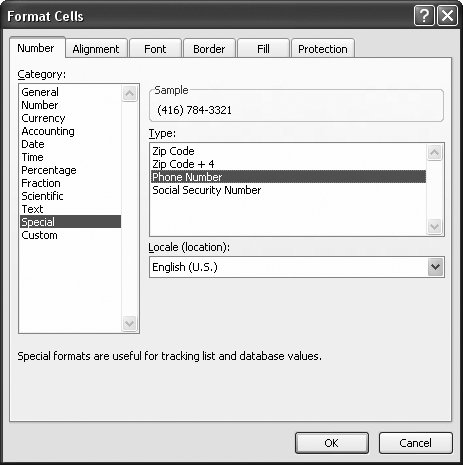Section 5.1. Formatting Cell Values
5.1. Formatting Cell ValuesCell value formatting is one aspect of worksheet design you don't want to ignore, because the values Excel stores can differ from the numbers that it displays in the worksheet, as shown in Figure 5-1. In many cases, it makes sense to have the numbers that appear in your worksheet differ from Excel's underlying values, since a worksheet that's displaying numbers to, say, 13 decimal places, can look pretty cluttered.
To format a cell's value, follow these steps:
You'll spend a lot of time in this chapter at the Format Cells dialog box. As you've already seen, the most obvious way to get there is to choose Home 5.1.1. Formatting NumbersIn the Format Cells dialog box, the Number tab lets you control how Excel displays numeric data in a cell. Excel gives you a lengthy list of predefined formats (as shown in Figure 5-4). Remember, Excel uses number formats when the cell contains only numeric information. Otherwise, Excel simply ignores the number format. For example, if you enter Half past 12 in a column full of times, Excel considers it plain ol' textalthough, under the hood, the cell's numerical formatting stays put, and Excel uses it if you change the cell content to a time.
When you create a new spreadsheet, every cell starts out with the same number format: General. This format comes with a couple of basic rules:
As you saw in Chapter 2, the way you type in a number can change a cell's formatting. For example, if you enter a number with a currency symbol, the number format of the cell changes automatically to Currency. Similarly, if you enter three numbers separated by dashes (-) or backward slashes (/), Excel assumes you're entering a date, and adjusts the number format to Date. However, rather than rely on this automatic process, it's far better just to enter ordinary numbers and set the formatting explicitly for the whole column. This approach prevents you from having different formatting in different cells (which can confuse even the sharpest spreadsheet reader), and it makes sure you get exactly the formatting and precision you want. You can apply formatting to the column before or after you enter the numbers. And it doesn't matter if a cell is currently empty; Excel still keeps track of the number format you've applied. Different number formats provide different options. For example, if you choose the Currency format, then you can choose from dozens of currency symbols. When you use the Number format, you can choose to add commas (to separate groups of three digits) or parentheses (to indicate negative numbers). Most number formats let you set the number of decimal places. The following sections give a quick tour of the predefined number formats available in the Format Cells dialog box's Number tab. Figure 5-5 gives you an overview of how different number formats affect similar numbers.
5.1.1.1. GeneralThe General format is Excel's standard number format; it applies no special formatting other than the basic rules described in Section 5.1.1.2. General is the only number format (other than Text) that doesn't limit your data to a fixed number of decimal places. That means if you want to display numbers that differ wildly in precision (like 0.5, 12.334, and 0.120986398), it makes sense to use General format. On the other hand, if your numbers have a similar degree of precision (for example, if you're logging the number of miles you run each day), the Number format makes more sense.
5.1.1.2. NumberThe Number format is like the General format but with three refinements. First, it uses a fixed number of decimal places (which you set). That means that the decimal point always lines up ( assuming you've formatted an entire column). The Number format also allows you to use commas as a separator between groups of three digits, which is handy if you're working with really long numbers. Finally, you can choose to have negative numbers displayed with the negative sign, in parentheses, or in red lettering. 5.1.1.3. CurrencyThe Currency format closely matches the Number format, with two differences. First, you can choose a currency symbol (like the dollar sign, pound symbol, Euro symbol, and so on) from an extensive list; Excel displays the currency symbol before the number. Second, the Currency format always includes commas. The Currency format also supports a fixed number of decimal places ( chosen by you), and it allows you to customize how negative numbers are displayed. 5.1.1.4. AccountingThe Accounting format is modeled on the Currency format. It also allows you to choose a currency symbol, uses commas, and has a fixed number of decimal places. The difference is that the Accounting format uses a slightly different alignment. The currency symbol is always at the far left of the cell (away from the number), and there's always an extra space that pads the right side of the cell. Also, the Accounting format always shows negative numbers in parentheses, which is an accounting standard. Finally, the number 0 is never shown when using the Accounting format. Instead, a dash (-) is displayed in its place. There's really no reason to prefer the Currency or the Accounting format. Think of it as a personal decision, and choose whichever looks nicest on your worksheet. The only exception is if you happen to be an accountant , in which case you really have no choice in the matterstick with your namesake. 5.1.1.5. PercentageThe Percentage format displays fractional numbers as percentages. For example, if you enter 0.5, that translates to 50%. You can choose the number of decimal places to display. There's one trick to watch out for with the Percentage format. If you forget to start your number with a decimal, then Excel quietly "corrects" your numbers. For example, if you type 4 into a cell that uses the Percentage format, Excel interprets this as 4%. As a result, it actually stores the value 0.04. A side effect of this quirkiness is that if you want to enter percentages larger than 100%, you can't enter them as decimals. For example, to enter 200%, you need to type in 200 (not 2.00). 5.1.1.6. FractionThe Fraction format displays your number as a fraction instead of a number with decimal places. The Fraction format doesn't mean you have to enter the number as a fraction (although you can if you want by using the forward slash, like 3/4). Instead it means that Excel converts any number you enter and display it as a fraction. Thus, to have 1/4 appear you can either enter .25 or 1/4. Note: If you try to enter 1/4 and you haven't formatted the cell to use the Fraction number format, then you won't get the result you want. Excel assumes you're trying to enter a date (in this case, January 4th of the current year). To avoid this misunderstanding, change the number format before you type in your fraction. Or, enter it as 0 1/4 (zero and one quarter). People often use the Fraction format for stock market quotes, but it's also handy for certain types of measurements (like weights and temperatures ). When using the Fraction format, Excel does its best to calculate the closest fraction, which depends on a few factors including whether an exact match exists (entering .5 always gets you 1/2, for example) and what type of precision level you've picked when selecting the Fraction formatting. You can choose to have fractions with three digits (for example, 100/200), two digits (10/20), or just one digit (1/2), using the top three choices in the Type list. For example, if you enter the number 0.51, Excel shows it as 1/2 in one-digit mode, and the more precise 51/100 in three-digit mode. In some cases, you may want all numbers to use the same denominator (the bottom number in the fraction) so that it's easy to compare different numbers. (Don't you wish Excel had been around when you were in grammar school?) In this case, you can choose to show all fractions as halves (with a denominator of 2), quarters (a denominator of 4), eighths (8), sixteenths (16), tenths (10), and hundredths (100). For example, the number 0.51 would be shown as 2/4 if you chose quarters . Tip: Entering a fraction in Excel can be awkward because Excel may attempt to convert it to a date. To prevent this confusion, always start by entering 0 and then a space. For example, instead of typing 2/3 enter 0 2/3 (which means zero and two- thirds ). If you have a whole number and a fraction, like 1 2/3, you'll also be able to duck the date confusion. 5.1.1.7. ScientificThe Scientific format displays numbers using scientific notation, which is ideal when you need to handle numbers that range widely in size (like 0.0003 and 300) in the same column . Scientific notation displays the first non-zero digit of a number, followed by a fixed number of digits, and then indicates what power of 10 that number needs to be multiplied by to generate the original number. For example, 0.0003 becomes 3.00 x 10 -4 (displayed in Excel as 3.00E-04). The number 300, on the other hand, becomes 3.00 x 10 2 (displayed in Excel as 3.00E02). Scientistssurprise, surpriselike the Scientific format for doing things like recording experimental data or creating mathematical models to predict when an incoming meteor will graze the Earth. 5.1.1.8. TextFew people use the Text format for numbers, but it's certainly possible to do so. The Text format simply displays a number as though it were text, although you can still perform calculations with it. Excel shows the number exactly as it's stored internally, positioning it against the left edge of the column. You can get the same effect by placing an apostrophe before the number (although that approach won't allow you to use the number in calculations).
5.1.2. Formatting Dates and TimesExcel gives you lots of options here. You can use everything from compact styles like 3/13/07 to longer formats that include the day of the week, like Sunday, March 13, 2007. Time formats give you a similar range of options, including the ability to use a 12-hour or 24- hour clock, show seconds, show fractional seconds, and include the date information.
To format dates and times, first open the Format Cells dialog box shown in Figure 5-7 (Home Excel has essentially two types of date and time formats:
The first group (the formats that rely on a computer's regional settings) is the smallest. It includes two date formats (a compact, number-only format and a long, more descriptive format) and one time format. In the Type list, these formats are at the top and have an asterisk next to them. The second group (the formats that are independent of a computer's regional settings) is much more extensive. In order to choose one of these formats, you first select a region from the Locale list, and then you select the appropriate date or time format. Some examples of locales include "English (United States)" and "English (United Kingdom)." If you enter a date without specifically formatting the cell, Excel usually uses the short region-specific date format. That means that the order of the month and year vary depending on the regional settings of the current computer. If you incorporate the month name (for example, January 1, 2007), instead of the month number (for example, 1/1/2007), Excel uses a medium date format that includes a month abbreviation, like 1-Jan-2007. Note: You may remember from Chapter 2 that Excel stores a date internally as the cumulative number of days that have elapsed since a certain long-ago date that varies by operating system. You can take a peek at this internal number using the Format Cells dialog box. First, enter your date. Then, format the cell using one of the number formats (like General or Number). The underlying date number appears in your worksheet where the date used to be. 5.1.3. Special Formats for Special NumbersYou wouldn't ever want to perform mathematical operations with some types of numeric information. For example, it's hard to image a situation where you'd want to add or multiply phone numbers or Social Security numbers. When entering these types of numbers, therefore, you may choose to format them as plain old text. For example, you could enter the text (555) 123-4567 to represent a phone number. Because of the parentheses and the dash (-), Excel won't interpret this information as a number. Alternatively, you could just precede your value with an apostrophe (') to explicitly tell Excel that it should be treated as text (you might do this if you don't use parentheses or dashes in a phone number). But whichever solution you choose, you're potentially creating more work for yourself because you have to enter the parentheses and the dash for each phone number you enter (or the apostrophe). You also increase the likelihood of creating inconsistently formatted numbers, especially if you're entering a long list of them. For example, some phone numbers may end up entered in slightly similar but somewhat different formats, like 555-123-4567 and (555)1234567. To avoid these problems, apply Excel's Special number format (shown in Figure 5-8), which converts numbers into common patterns. And lucky you: In the Special number format, one of the Type options is Phone Number (other formats are for Zip codes and Social Security numbers).
|
EAN: N/A
Pages: 75
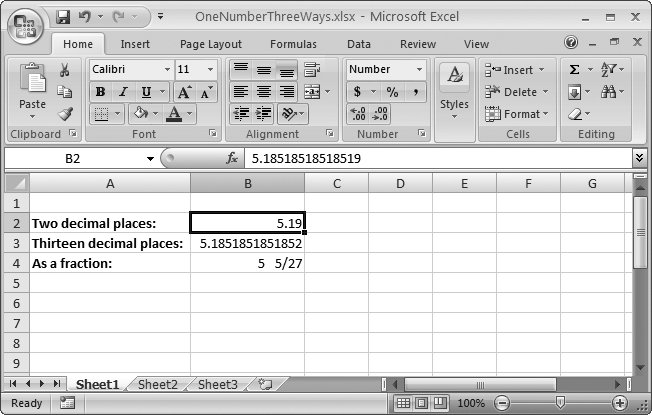
 Cells
Cells 